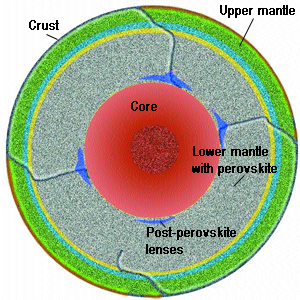 Last year’s
discovery of a new form of the mineral that makes up most of Earth’s lower
mantle set the stage for a potential transformation in understanding how the
planet works. A team of scientists has taken that mineral’s properties
together with seismic observations of the core-mantle boundary to propose a
new model that could elucidate the heat engine that drives Earth.
Last year’s
discovery of a new form of the mineral that makes up most of Earth’s lower
mantle set the stage for a potential transformation in understanding how the
planet works. A team of scientists has taken that mineral’s properties
together with seismic observations of the core-mantle boundary to propose a
new model that could elucidate the heat engine that drives Earth.In this schematic of Earthís interior, lenses of a newly found crystal structure (dark blue) of perovskite (light gray) sit above the core-mantle boundary. The mineralís theoretical behavior allows researchers to calculate the heat given off by the core and transmitted through the planet. Courtesy of John Hernlund.
Geophysicists sometimes compare the planet to a pot of soup boiling on a stove: The stove’s heat is transferred through the metal pot to the soup inside, which churns to get rid of that heat, affecting the layer of froth that sits on top. Using seismic waves, geophysicists can “see” the different layers of pot and soup, and sometimes pieces floating in the mantle soup — ocean crustal slabs. For decades, scientists have observed an unexpected layer inside this pot, a discontinuity several hundred kilometers above where the core and mantle meet called the D double prime (D") layer. But until now, they have not known what causes the lumpy topography observed there.
Now scientists think they have found some answers in perovskite, a mineral known to make up the bulk of Earth’s innards. At the D" layer, perovskite shifts its crystal structure according to temperature and pressure (like graphite changing to diamond) to a “post-perovskite” phase, the recently discovered form. That transition should show up as one reflection boundary when seismic waves cross it. But John Hernlund of the University of California, Los Angeles, and his colleagues recently found two instances where seismic waves reflected twice beneath Eurasia and the Caribbean. Although inklings of such double reflections have been observed in the past, this is the first well-recorded instance and has led the researchers to think that the waves passed through two separate phase-change boundaries.
The seismic waves indicate depths of those changes, which translate to pressure and allowed the team to determine the temperature changes in the deep mantle, as reported in the April 14 Nature. “Phase transitions in Earth’s minerals are natural thermometers, because the pressure at which they happen depends on temperature,” wrote Michael Wysession and Viatcheslav Solomatov of Washington University in St. Louis, Mo., in an accompanying comment in Nature.
The team was thus able to calculate that the core of the planet gives off about 9 to 13 terawatts of heat, about a quarter of the total that is released at the planet’s surface (past estimates have been at around 3 to 10 terawatts). Such a tremendous heat flow, Wysession and Solomatov wrote, is more than enough to account for the planet’s geodynamo (which generates the magnetic field) and could mean that the amount of heat flowing upward in mantle plumes is larger than previously thought.
Addressing the extent and variability of the D" layer has been a main focus of geophysics for the past several decades to address how much heat moves through the planet, Wysession says. The new model, supported by the team’s new seismic observations, is “an early speculation based on those results, but it’s very elegant,” he says, and “a neat way to address those problems that we haven’t yet solved.”
Although Thorne Lay of the University of California, Santa Cruz, calls the model “an intriguing idea,” he says it may not cover the “complexities of real rocks in Earth,” which could contain minor amounts of aluminum, calcium and iron that would throw off any theoretical calculations of the mantle’s mineral properties. Lay also says that the recent seismic observations are subject to different interpretations, which in the end may not support such double transitions.

